What Is Long Division? Explained For Elementary School
Long division, also known as the standard algorithm for division, is introduced in 5th grade. It is important that children understand the concept of division before this method is taught as this formal method is quite an abstract process. The long division method is usually used to divide by divisors with two or more digits.
What is long division?
Long division is a formal method of division often called the bus stop method or the standard algorithm.
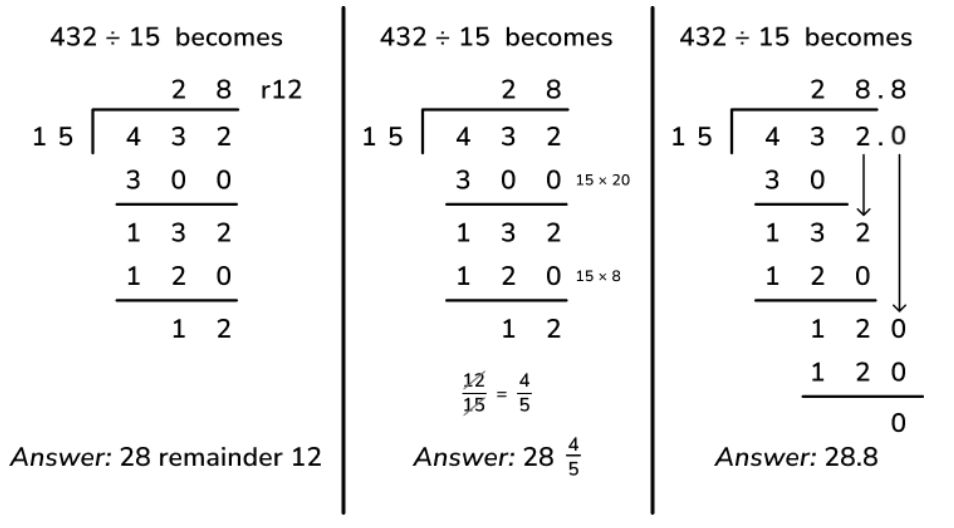
It is different from the short division method in that the long division written method is less compact. The long method of division is most often used when dividing by large numbers – in the curriculum, this is usually a 2-digit number (or three digits as a challenge).
It can be used with or without remainders. The first two examples above are more commonly known as the ‘partial quotients method’ or ‘chunking’; the third example is an expanded version of the short division method.
See also: What is division
Teaching Long Division Worksheets
Everything you need to teach long division in class and for homework in one place! 3 ready-to-use worksheets with answers to help students with all aspects of long division.
Download Free Now!Long division method: How to do long division
Long division is laid out in the same way as short division: The dividend (the number being divided) goes under the ‘bus stop’ or ‘house’ (or whatever nickname you refer to it as), the divisor (number the dividend is being divided by) goes to the left of the ‘bus stop,’ and the quotient (answer) goes on top, with each place value aligned with the dividend.
Chunking or Partial Quotients
The example below uses the ‘chunking’ or ‘partial quotients’ form of long division to calculate 432 ÷ 15.
This variation of the method involves ‘chunking’ a section of the dividend a bit at a time – first by subtracting 20 groups of the divisor, which leaves 132, then by subtracting another 8 groups of the divisor, which leaves 12.
As this amount is smaller than the divisor, this is the remainder. The quotient is 28, so the final answer is 28 r12 (or, if represented as a fraction, 28 and 12/15 or 28 and ⅘ when simplified).
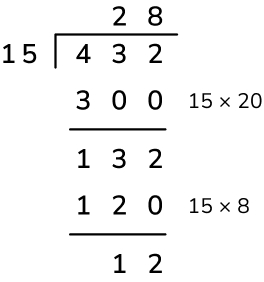
Long division steps
There are five long division steps that can be used to simplify this version of the method:
- Divide
- Multiply
- Subtract
- Bring the next number down
- Repeat
See how the steps are applied using this example:
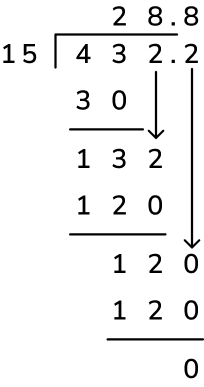
1. Divide: Starting with the first digit of the dividend, divide 4 hundreds by 15. We cannot do this, so a 0 could be placed above the 4 here, but instead we can just see the 4 hundreds as 40 tens alongside the 3 tens (the next digit of the dividend).
Now divide 43 tens by 15, which is 2 tens. This digit is placed above the 3 tens and becomes the first digit of the quotient.

2. Multiply: We need to calculate the remainder for this first step of the division – to do this, first multiply the first digit of the quotient, 2 tens, by the divisor, 15, to get 30 tens. Place this underneath the dividend, making sure to align the place values correctly.
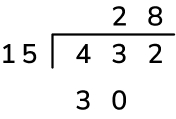
3. Subtract: To finish calculating the remainder for this first step of the division, finally subtract 30 tens from 43 tens to get 13 tens.
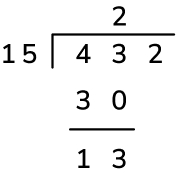
4. Bring the next digit down: In short division, we would place the remainder from each step before the next digit in the dividend – in this case, the 13 would be written to the top left of the digit ‘2’ to read 132. In long division, we just bring the next digit of the quotient down – this achieves the same thing but is just a bit easier to read!
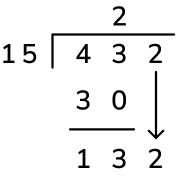
5. Repeat: Now we start the division process again from…
– Step 1: divide (divide 132 ones by 15 and place the answer, 8 ones, in the quotient); – Step 2: multiply (multiply the next digit of the quotient, 8 ones, by the divisor, 15, and place the answer, 120 ones, underneath 132 ones);
– Step 3: subtract (finish calculating the remainder to this next step by subtracting 120 ones from 132 ones to get 12 ones);
– Step 4: bring the next digit down (as the quotient won’t be a whole number, we will need to add a decimal point and a zero to calculate the remainder as a decimal, so the zero gets brought down to make 120 tenths);
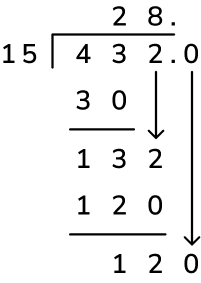
– Step 5: repeat (divide 120 tenths by 15 to get 8 tenths and place this in the quotient as the first – and only – decimal place; multiply 8 tenths by 15 to get 120 tenths; subtract this from 120 tenths to calculate the remainder, which is 0; there is now no next digit to bring down so, as the remainder is now 0, the calculation is complete).
As you can see from the example below, short division can also be used to solve this calculation – both methods give the correct answer but the ‘long’ method is just the expanded version of the ‘short’ method.
Rather than doing some of the calculations mentally in the short division method to calculate the remainder for each step (to work out the remainder of the first step as 13 tens, or 130 ones, and the second step as 12 ones, or 120 tenths), long division lays these same calculations out as part of the method itself.
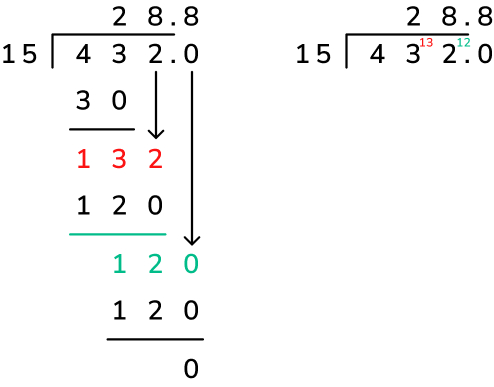
How to explain long division
If children struggle with multiplication and division, particularly multiplication tables, it helps to list multiples of the divisor before completing the division to reduce the cognitive demand on the child when working through the method.
This can be done with short division too, but let’s use the example practice problems above to show how listing the multiples would help.
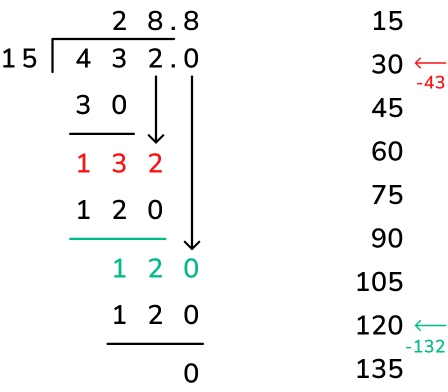
First, list 9 multiples of the divisor: this can be done by repeated addition (15 + 15 = 30, + 15 = 45, + 15 = 60, etc.) or partitioning (15 can be partitioned into 10 and 5; list the multiples of 10 – 10, 20, 30 etc. – and the multiples of 5 – 5, 10, 15 etc. – and then add them together to create each multiple – 10 + 5 = 15, 20 + 10 = 30, 30 + 15 = 45 etc.).
When completing step 1 of the long division method (the expanded version of short division), the multiples make it a lot easier. First, in the example above, use the multiples to calculate 43 tens divided by 15 – we can see that 43 ‘fits’ above 30, which is 2 multiples of 15.
We can continue the division process until we get to the ‘repeat’ step and calculate 132 ones divided by 15 – we can see that 132 ‘fits’ above 120, which is 8 multiples of 15.
To ease the children into this version of the long division method, try it first with a one digit divisor. They will no doubt be used to applying the short division method when dividing by one digit, but comparing both (as in the example below) is a clear sequential step between the short and long method.
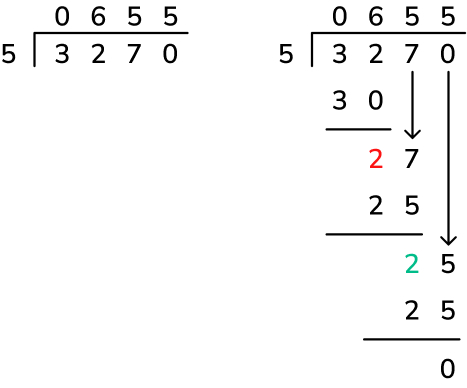
Read for more detail about the long division method in 5th grade.
When do children learn about long division in school?
Long division, or the standard algorithm, does not appear in the Common Core standards until 6th grade, although some other states, such as Texas (TEKS), introduce the standard algorithm in 5th grade.
Note that it is very common even in states that follow Common Core for teachers to show students the long division method in 5th grade even though it is not required. In the CCSS, students are introduced to the ‘partial quotients’ or ‘chunking’ method in 4th grade (up to 4-digit by 1-digit) and 5th grade (4-digit by 2-digit).
This lays the foundation for long division. By 5th grade, students should be able to interpret remainders as whole number remainders, fractions, or by rounding, as appropriate for the context. These fundamental skills are very important to prepare students for middle school math and even high school math.
How does long division relate to other areas of math?
Long division may be required in multi-step problems (word problems requiring more than one mathematical operation to solve it, e.g. addition and multiplication), but as the cognitive demand of a math problem like this is already quite high, it’s more likely that a short division method would be more appropriate for whatever division may be expected.
How does long division link to real life?
Whenever something needs to be shared equally between a large number of groups and the division cannot be done mentally, long division can be used.
Long division worked examples
1.45,041 ÷ 73
Answer: 617
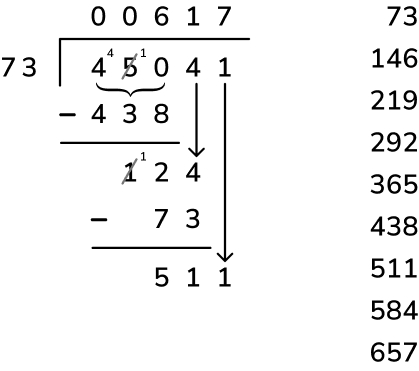
2. Adam is making booklets. Each booklet must have 34 sheets of paper. He has 2 packets of paper. There are 500 sheets of paper in each packet. How many complete booklets can Adam make from 2 packets of paper?
Answer: 2 packets of 500 sheets = 1,000 sheets. 1,000 ÷ 34 = 29 complete booklets
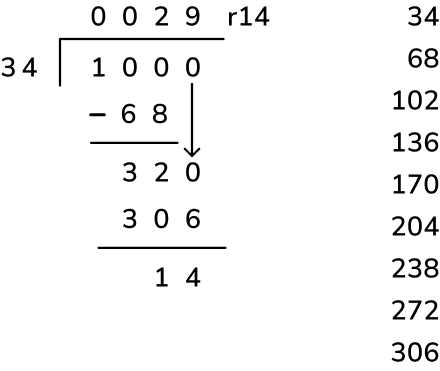
3. A grocery store manager needs to order 1,176 apples. Apples are sold in trays containing 28 apples. How many trays of apples does the manager need to order?
Answer: 1,176 ÷ 28 = 42 trays
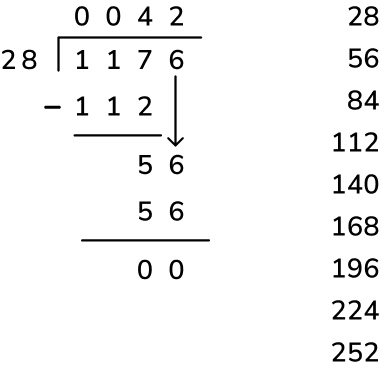
Practice long division problems
- 1,632 ÷ 24. Answer: 68
- 42,028 ÷ 79. Answer: 532
- For a school trip, each bus holds 42 passengers. If there are 521 children and teachers in total, how many buses does the school need to book? Answer: 13 buses
- A factory makes 4,923 toy cars which are packed in boxes of 15. How many toy cars are left over? Answer: 3
- 21 people each win an equal share of $9,072. How much does each person win? Answer: $432
Looking for more division and long division resources? Third Space Learning offers a comprehensive library of elementary and middle school math resources. See our blogs on our long division examples and long division questions.
In addition to teaching and learning resources, including long division worksheets, Third Space Learning also offers one-to-one online tutoring to support students. Personalized to the needs of each individual child, our online tutoring courses aim to fill gaps in learning and boost confidence in math.
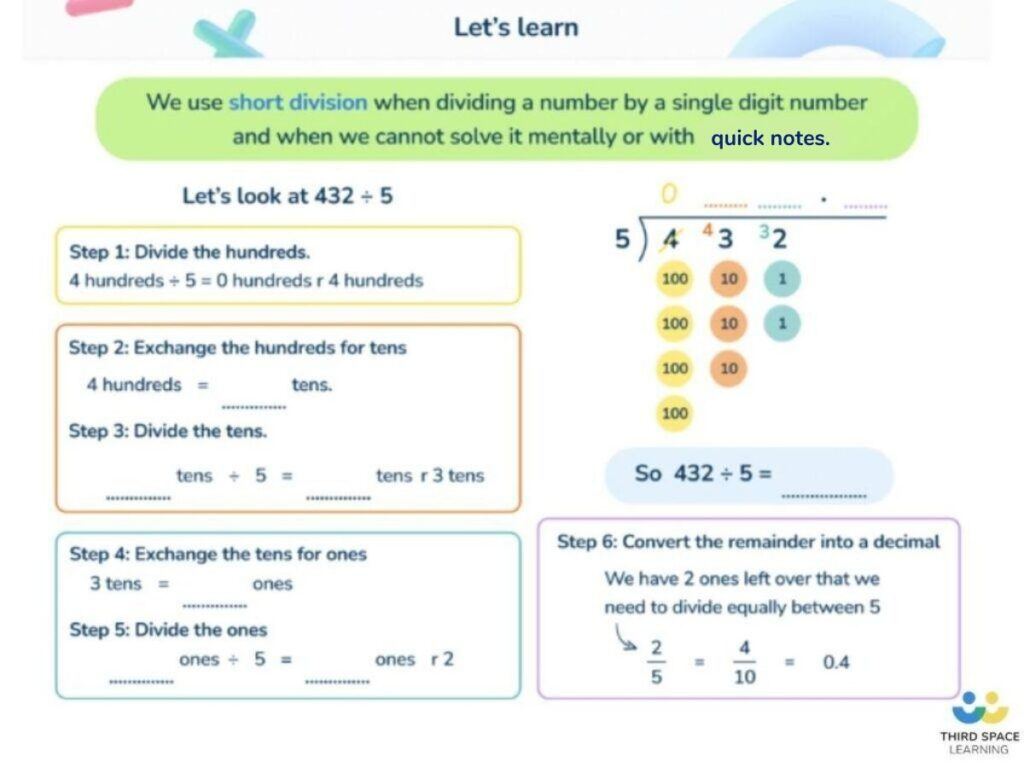
Long division FAQs
Divide, multiply, subtract, bring the next digit down and repeat the previous steps.
Long division is the expanded version of short division – each step is exactly the same but we just write it out instead of doing it mentally!
When dividing by larger numbers, it is often more accurate than short division because there is less we have to ‘hold’ in our head – all the calculations are laid out for us.
Do you have students who need extra support in math?
Give your students more opportunities to consolidate learning and practice skills through personalized math tutoring with their own dedicated online math tutor.
Each student receives differentiated instruction designed to close their individual learning gaps, and scaffolded learning ensures every student learns at the right pace. Lessons are aligned with your state’s standards and assessments, plus you’ll receive regular reports every step of the way.
Personalized one-on-one math tutoring programs are available for:
– 2nd grade tutoring
– 3rd grade tutoring
– 4th grade tutoring
– 5th grade tutoring
– 6th grade tutoring
– 7th grade tutoring
– 8th grade tutoring
Why not learn more about how it works?
The content in this article was originally written by primary school teacher Sophie Bartlett and has since been revised and adapted for US schools by elementary math teacher Katie Keeton.





